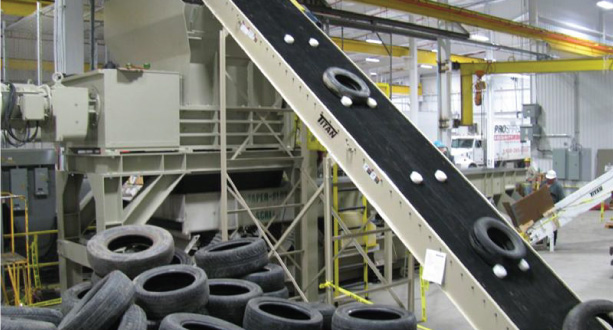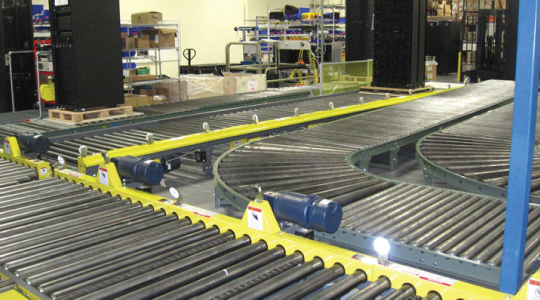Industrial conveyor belts are a vital component in operational efficiency in material handling solutions. But, with so much choice out there — and so many different facts and figures relating to each option — how do you make sure you are choosing the right belt for your business?
We want to make the selection process easier, empowering you with the information you need to make the right choice. With this in mind, we created this handy guide to selecting the ideal industrial conveyor belt system.
10 CONSIDERATIONS WHEN CHOOSING AN INDUSTRIAL CONVEYOR BELT
ULTIMATE TENSILE STRENGTH
Ultimate Tensile Strength, or UTS, is a strength rating that is applied to industrial conveyor belts. It refers to the maximum force that a conveyor belt can withstand before it begins to lose its structural integrity — something that may result in the belt stretching or even breaking. Conveyor belts designed for more heavy-duty industrial applications will have a higher UTS rating. As the rating is universally applied, you will be able to use it as you compare products from different conveyor belt manufacturers.
MAXIMUM WORKING TENSION
While the UTS refers to the tensile strength limits of the conveyor belt at rest, the Maximum Working Tension rating is arguably more useful in industry. This rating refers to how much tension a conveyor belt can withstand during its operation without sustaining damage. While the conveyor belt may not be under as much strain as a component like a power transmission belt, it will still need to be able to operate at a certain level of tension. Again, conveyor belts deployed in heavy industry are likely to feature high Maximum Working Strength ratings.
IMPACT RATING
Depending on the use case for your conveyor belt, the impact rating may be something you need to consider. This rating refers to the force that the belt is able to withstand in the event of an object falling onto it from a height. In many applications, this will be a regular occurrence as rubble or other heavy materials may need to be deposited on the conveyor from a hopper or conduit. If your facility handles food processing or other lighter-duty activities, this may not be so important. But, it is something that those working in heavy-industry will need to be aware of.
OPERATING ENVIRONMENT
The environment you are operating in must be taken into account when you select an industrial conveyor belt. If you are working in an anti-static environment, or anywhere deemed high-risk due to flammable particles in the atmosphere, you need to make sure that the belt you choose is rated for this application. Failing to make sure of this could leave you, your team, and the general public at risk.
BELT FLEXIBILITY AND PLIABILITY
In some instances, it may be necessary to manipulate the conveyor belt into a trough shape to aid the transportation of materials. If this is the case at your facility, you will need to make sure that the belt is up to the task. Make sure it can be easily manipulated into shape by the belt rollers before returning to the standard flat profile when it cycles back to the beginning of its route. The belt will need to maintain its rigid structure when it is troughed, bending at key points rather than sagging, and should not become pinched by the supporting structure.
TRANSITION DISTANCE
The transition distance is another important consideration if you need to manipulate your conveyor into a troughed profile. This refers to the distance that the conveyor belt will need to travel in its flat, un-angled profile before it reaches the point of transition into the troughed profile. It all comes down to the angle at which the belt will be troughed. The greater the angle, the greater the transition distance will need to be. Operating with a transition distance that is too short could put undue stress and strain on your belt during operation.
GRADIENTS
If you need to transport materials and products from one level to another, it will be necessary to angle your conveyor to form a gradient. For this application, the flexibility and pliability of the conveyor belt itself, mentioned above, will come back into question. You will also need to choose a belt with an appropriate level of surface layer friction to transport items efficiently up the slope.
COVERAGE
A conveyor belt is a durable piece of hardware that is designed for industrial applications. However, this does not mean that it is not susceptible to wear and tear, or that you can’t take steps to extend the life of the equipment. If you are working with materials that feature sharp edges, are corrosive, or may be falling onto the belt from a height, you may decide to opt for a conveyor belt with a protective layer to keep your equipment running smoothly and effectively for longer.
INTEGRATION WITH OTHER EQUIPMENT
Will your warehouse conveyor system require a simple transition from point A to point B, or is it a little more complicated, interacting with other pieces of equipment in your facility? This is something to consider when selecting your conveyor belt, as you will need to make sure that the belt can efficiently transmit material to where it needs to be. Structural connection points can help you to achieve this with your conveyor belt set up.
CONVEYOR ROUTE
It may be necessary for your industrial conveyor belt to go around corners or to change direction. This will be possible with many types of conveyor belts, but these belts may not be suitable for all applications. For example, if it is critical that your products and materials maintain a consistent orientation at all points on the route, you may need to install structural elements within your system that make this possible.
GET THE RIGHT CONVEYOR BELT FOR YOUR BUSINESS
If you still have questions, you can always reach out to our friendly and knowledgeable team. We can help you determine the best conveyor system according to your current space, business model, vision for growth, and budget.


